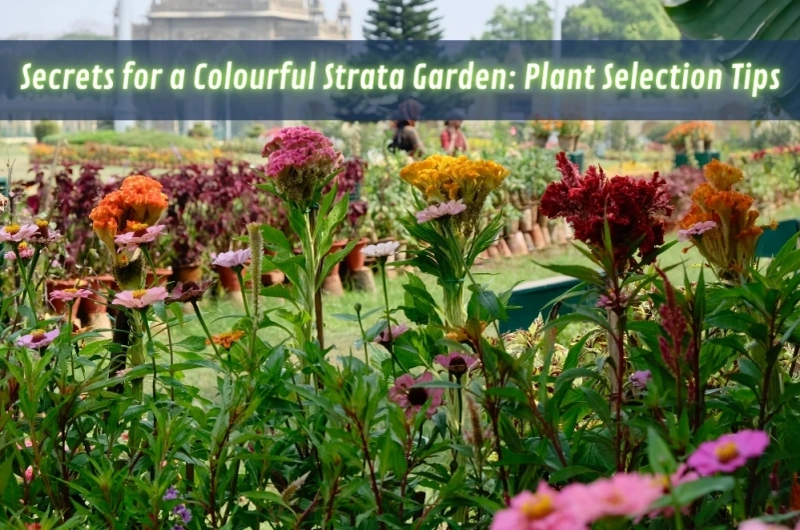Ever walk past a strata complex and think, "Wow, those gardens are amazing," while your gardens look a bit…plain? You're not alone. Many strata residents struggle to create colourful outdoor spaces, often because of limited space, shared responsibilities, and specific strata regulations. But fear not! Achieving a stunning, colourful strata garden is absolutely possible, and it all starts with brilliant plant selection. Discover the art of strata gardening in Sydney and unlock secrets to transforming your shared space into a vibrant oasis.
Vibrant strata gardens: Plant selection secrets
A good strata garden starts with the right plants. This is not a matter of choosing beautiful flowers but one of considering what your space will be like: sun, soil, water, and overall aesthetic. By selecting plants well-suited to these factors, you can rest assured that they will thrive and require less maintenance while maximising colour.
- Assess the space: How much direct sun does it get? Is the soil well-draining or clay-based? Are there any microclimates, such as a sheltered corner or exposed to windy gusts?
- Consider your strata rules: Some strata schemes restrict plant types, sizes, or even colours. Check your by-laws before making any purchases.
- Consider the upkeep: What time and energy would residents realistically be able to devote to gardening? If time is limited, it's best to use varieties that require less.
Colour theory for strata spaces
Just as an artist mixes from a colour palette, you can work with colour theory to make a strata garden pleasing to the eye. Incorporate the uses and benefits of garden decks and colours, which work together and can guide you in using complementary colours and creating harmony.
- Complementary colours: These are colours opposite one another on the colour wheel. Examples include blue and orange, red and green. They contrast and make each other pop with a vibrant, rich look. Imagine deep purple lavender paired with bright yellow marigolds.
- Analogous colours are colours on the colour wheel that are adjacent to each other (such as blue, purple, and violet). They give a softer and more harmonious effect. Envision a variety of shades of pink and red roses.
- Monochromatic schemes: Using the different shades and tints of a single colour can create an elegant and unifying effect. Imagine a garden with a range of shades of green foliage along with white flowers scattered throughout.
Vertical gardening: Maximising colour in limited spaces
In strata living, space is often a premium. However, this doesn't necessarily mean that you have to compromise on colour. Vertical gardening is a brilliant solution for maximising colour in limited spaces. Grow your plants upwards and create striking green walls, cascading displays, and vibrant focal points.
- Wall planters: These are available in all shapes and sizes and can be attached to a wall or a fence. They are great for herbs, strawberries, and colourful annuals.
- Baskets: These are used to hang under a window, where the trailing petunias, fuchsias, and geraniums put on a fabulous display of colourful splashes at eye level.
- Trailing plants such as jasmine, climbing roses, or bougainvillea can be trained up onto trellises or pergolas for a theatrical and fragrant display.
Year-round brilliance: Planting for seasonal colour
A really beautiful strata garden will give colour throughout the year. Planting the right flowers in every season ensures that beauty remains alive all the time.
- Spring: Celebrate spring with new life by using tulips, daffodils, and hyacinths as bulbs. Boost it with pansies and Viola's annual flowers.
- Summer: Select heat-tolerant plants like geraniums, petunias, and salvia. Think about using native Australian plants that are accustomed to the heat of summer.
- Autumn: Use the warm tones of autumnal foliage by planting maples and liquidambars. Late-season colour comes with chrysanthemums and asters.
- Winter: Choose plants for interesting foliage or berries, such as camellias, nandina, and winter-flowering heaths.
Low-maintenance plants for strata gardens
Low-maintenance plants are a godsend in busy strata communities. These hardy varieties require minimal care, allowing residents to enjoy a colourful garden without excessive effort.
- Native Australian plants: Embracing local and native plants that are well adapted to local conditions and generally require less water and maintenance than introduced species. Consider grevilleas, kangaroo paws, and wattles for vibrant colour and minimal fuss.
- Succulents: These are plants that tolerate drought well, come in a range of colours and shapes, and are ideal for dry, sunny places.
- Perennials: These return every year, thus providing dependable colour without much replanting. Examples include lavender, rosemary, and echinacea.
Conclusion: Colourful strata gardens
A colourful strata garden provides an oasis for any community within reach. By considering the local conditions of your space, learning about the principles behind colour theory, and selecting suitable plants, Consider gardening advice from a local gardener so you can quickly transform your shared outdoor space into a verdant oasis. Always check with strata by-laws, involve residents in planning processes, and opt for low-maintenance options for a sustainable and more enjoyable garden. A little planning and effort would make your strata garden a proud spot to enjoy for everyone. Thinking about effective strata gardening? Consider how factors like shared spaces and community involvement influence plant choices.



